
The Dungeness crab, Metacarcinus magister or Cancer magister, is a species of crab that inhabits eelgrass beds and water bottoms on the west coast of North America. It typically grows to 20 cm (7.9 in) across the carapace and is a popular seafood. Its common name comes from the port of Dungeness, Washington, United States, where it is "a prized crustacean that supports the most valuable fishery on the west coast", and where ocean acidification threatens the marine environment.

Mullus barbatus is a species of goatfish found in the Mediterranean Sea, Sea of Marmara, the Black Sea and the eastern North Atlantic Ocean, where its range extends from Scandinavia to Senegal. They are fished, mostly by trawling, with the flesh being well regarded. The International Union for Conservation of Nature has assessed their conservation status as being of "least concern".
Cherax parvus is a species of crayfish in the family Parastacidae. It is only known from its type locality – the Upper Tully River catchment in the Cardwell Range of north-eastern Queensland – and is listed as data deficient on the IUCN Red List. It was discovered in a rainforest catchment in a highland of northeastern Queensland during a Queensland Museum expedition to the upper Tully River area in November 1992. It is one of the smallest species in the genus. No species of Cherax has been considered endemic to wet upland or highland areas before it was discovered; most previous records were from elevations less than 400 meters. It also has several morphological features unique to the genus, and does not appear closely related to any extant species, suggesting a long period of geographic isolation.

Tachypleus tridentatus, commonly known as the Chinese horseshoe crab, Japanese horseshoe crab, or tri-spine horseshoe crab, is a species of horseshoe crab found in Southeast and East Asia, with records from China, Indonesia, Japan, South Korea, Malaysia, the Philippines, Taiwan, and Vietnam. It is found in coastal marine and brackish waters, and tolerates colder temperatures than the other Asian horseshoe crabs, although juveniles still need water warmer than 22 °C (72 °F) to moult.

Thalassina is a genus of mud lobsters found in the mangrove swamps of the Indian Ocean and western Pacific Ocean. Its nocturnal burrowing is important for the recycling of nutrients in the mangrove ecosystem, although it is sometimes considered a pest of fish and prawn farms.

Goneplax rhomboides is a species of crab. It is known by the common name angular crab because of its angular carapace. Although it is also called the square crab, its shell is in fact more trapezoidal than square. This species is also known as the mud-runner because they are able to run away quickly when threatened.
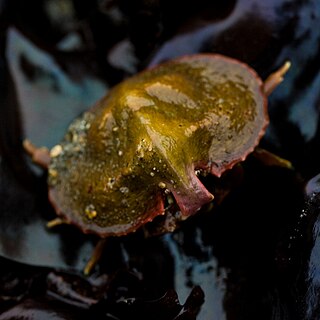
Cryptolithodes sitchensis, variously known as the umbrella crab, Sitka crab or turtle crab, is a species of lithodid crustacean native to coastal regions of the northeastern Pacific Ocean, ranging from Sitka, Alaska to Point Loma, California. Its carapace extends over its legs such that when it pulls in its legs, it resembles a small stone. It lives in rocky areas from the low intertidal to depths of 17 m (56 ft).

Pseudosquilla ciliata, the common mantis shrimp, is a species of mantis shrimp, known by common names including rainbow mantis shrimp and false mantis shrimp. It is widespread in the tropical Indo-Pacific region and in both the western and eastern Atlantic Ocean.

Eumunida picta is a species of squat lobster found in the deep sea. The species is strongly associated with reefs of Lophelia pertusa, a deep-water coral, and with methane seeps. It is abundant in the western Atlantic Ocean, where it is found from Massachusetts to Colombia.
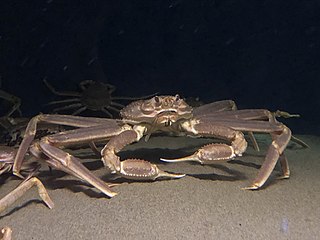
Chionoecetes opilio, is a species of snow crab, also known as opilio crab or opies, is a predominantly epifaunal crustacean native to shelf depths in the northwest Atlantic Ocean and north Pacific Ocean. It is a well-known commercial species of Chionoecetes, often caught with traps or by trawling. Seven species are in the genus Chionoecetes, all of which bear the name "snow crab". C. opilio is related to C. bairdi, commonly known as the tanner crab, and other crab species found in the cold, northern oceans.

Pugettia gracilis, commonly known as the graceful kelp crab, is a species of small crab in the family Epialtidae. It lives among forests of kelp on the Pacific coast of North America.

Lybia tessellata is a species of small crab in the family Xanthidae. It is found in shallow parts of the tropical Indo-Pacific Ocean. Like other members of the genus Lybia, it is commonly known as the pom-pom crab or boxer crab because of its habit of carrying a sea anemone around in each of its claws, these resembling pom-poms or boxing gloves.

Oregonia bifurca, commonly known as the split-nose crab or the split-nose decorator crab, is a species of crabs belonging to the genus Oregonia. It is a rare deep-water species that inhabits the tops of seamounts and guyots in the northeastern Pacific Ocean; from the Aleutian Islands, the Bering Sea, the Hawaiian–Emperor seamount chain, to the waters off British Columbia. It is closely related to the more common shallow-water species Oregonia gracilis, the graceful decorator crab.
Cymo melanodactylus, the furry coral crab, is a species of small decapod crustacean in the family Xanthidae. It is found in the Indo-Pacific Ocean and lives in crevices and on the surface of corals in the genus Acropora.
Sicyonia ingentis is a species of prawn in the family Sicyoniidae known by the common name ridgeback prawn. It is native to the eastern Pacific Ocean, where it occurs along the coast of California and Baja California, its distribution extending from Monterey Bay to Isla María Madre off Nayarit. It also lives in the Gulf of California. Other common names include Pacific rock shrimp and Japanese shrimp. In Spanish it is called camarón de piedra del Pacífico and cacahuete.
Procaris hawaiana is a species of shrimp in the family Procarididae, from Maui, Hawaii. The species is very similar to Procaris ascensionis from Ascension Island. In P. ascensionis the integument is less firm, the rostrum is shorter, the cervical groove is more distinct, and the third abdominal somite reaches less far posteriorly over the fourth; also the scaphocerite has the final tooth still less distinct than in P. hawaiana, and the last segment of its antennal peduncle is less slender.
Palaemonella burnsi is a species of shrimp in the family Palaemonidae, from Maui, Hawaii. This species is closest to Palaemonella lata, which it resembles in the broad scaphocerite in which the lamella overreaches the final tooth, and in the unarmed merus of the second pereiopods. It differs from P. lata in the much longer fused part of the two branches of the upper antennular flagellum, in the relatively much longer fingers and shorter palm of the second legs, in the unarmed carpus of the second legs. It is named after John A. Burns, Governor of Hawaii, for declaring the Ahiki Kinau area a nature reserve.
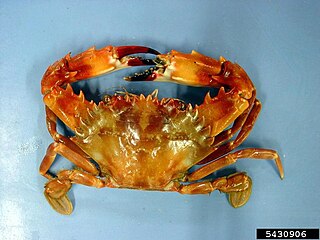
Charybdis hellerii, the Indo-Pacific swimming crab or spiny hands is a species of crab from the swimming crab family, the Portunidae. Its native range covers the Indian and Pacific Oceans but it has been introduced to the western Atlantic and has invaded the Mediterranean. It is a commercially exploited species in south-east Asia.
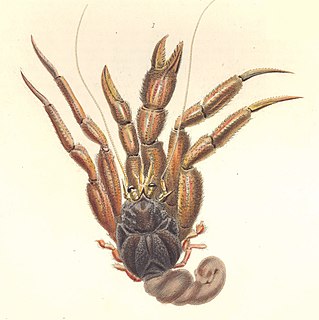
Labidochirus splendescens, commonly known as the splendid hermit crab, is a species of hermit crab found in the northeastern Pacific Ocean off the coast of North America. It is more heavily calcified and inhabits smaller mollusc shells than most hermit crabs.
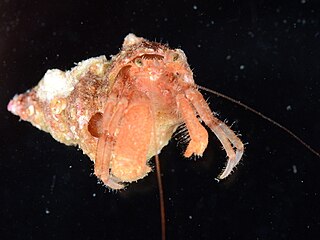
Pagurus dalli, commonly known as the whiteknee hermit, is a species of hermit crab in the family Paguridae. It is found in the northeastern Pacific Ocean at depths down to about 276 m (900 ft). It usually lives in a mutualistic symbiosis with a sponge, or sometimes a hydroid.














